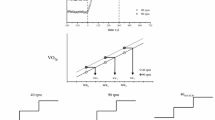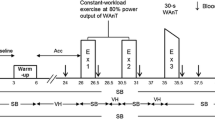Abstract
The stability of arterial PCO2 (PaCO2) during moderate exercise in humans suggests a CO2-linked control that matches ventilation (V̇E) to pulmonary CO2 clearance (V̇CO2). An alternative view is that V̇E is subject to long-term modulation (LTM) induced by “hyperpnoeic history”. LTM has been reported with associative conditioning via dead-space (VD) loading in exercising goats (Martin and Mitchell 1993). Whether this prevails in humans is less clear, which may reflect differences in study design (e.g. subject familiarisation; VD load; whether or not V̇E is expressed relative to V̇CO2; choice of PaCO2 estimator). After familiarisation, nine healthy males performed moderate constant-load cycle-ergometry (20 W-80 W-20 W; <lactate threshold, θL): day 1, pre-conditioning, n=3; day 2, conditioning (VD=1.59 l, doubling V̇E at 20 W and 80 W), n=8 with 10 min rest between tests; and, after 1 h rest, post-conditioning, n=3. Gas exchange was determined breath-by-breath. Post-conditioning, neither the transient [phase 1, phase 2 (Ф1, Ф2)] nor steady-state V̇E exercise responses, nor their proportionality to V̇CO2, differed from pre-conditioning. For post-conditioning trial 1, steady-state V̇E was 28.1 (4.7) l min−1 versus 29.1 (3.8) l min−1 pre-conditioning, and mean-alveolar PCO2 (a validated PaCO2 estimator) was 5.53 (0.48) kPa [41.5 (3.6) mmHg] versus 5.59 (0.49) kPa [41.9 (3.7) mmHg]; the Ф1 V̇E increment was 4.2 (2.9) l min−1 versus 5.2 (1.9) l min−1; the Ф2 V̇E time-constant (τ) was 64.4 (24.1) s versus 64.1 (25.3) s; τV̇E/τV̇CO2 was 1.12 (0.04) versus 1.10 (0.04); and the V̇E-V̇CO2 slope was 21.7 (3.4) versus 21.2 (3.2). In conclusion, we could find no evidence to support ventilatory control during moderate exercise being influenced by hyperpnoeic history associated with dead-space loading in humans.






Similar content being viewed by others
References
Adams L, Moosavi S, Guz A (1992) Ventilatory responses to exercise in man increases by prior conditioning of breathing with added dead space. Am Rev Respir Dis 145:A882
Beaver WL, Wasserman K, Whipp BJ (1973) On-line computer analysis and breath-by-breath graphical display of exercise function tests. J Appl Physiol 34:128–132
Cao K-Y, Zwillich CW, Berthon-Jones M, Sullivan CE (1992) Increased normoxic ventilation induced by repetitive hypoxia in conscious dogs. J Appl Physiol 73:2083–2088
Dempsey JA, Forster HV, Ainsworth DM (1995) The regulation of hyperpnea, hyperventilation and respiratory muscle recruitment during exercise. In: Dempsey JA, Pack AI (eds) Regulation of breathing. Dekker, New York, pp1065–1134
DuBois AB, Britt AG, Fenn WO (1952) Alveolar CO2 during the respiratory cycle. J Appl Physiol 4:535–548
Eldridge FL, Millhorn DE (1986) Oscillation, gating and memory in the respiratory control system. In: Widdicombe JG, Cherniack N (eds) Handbook of physiology, respiration (control). American Physiological Society, Washington, DC, pp93–114
Farhi LE, Rahn H (1955) Gas stores in the body and the unsteady state. J Appl Physiol 7:472-484
Helbling D, Boutellier U, Spengler CM (1997) Modulation of the ventilatory increase at the onset of exercise in humans. Respir Physiol 109:219–229
Honda Y (1992) Respiratory and circulatory activities in carotid body-resected humans. J Appl Physiol 73:1–8
Johnson RA, Mitchell GS (2001) p-Chlorophenylalanine eliminates long term modulation of the exercise ventilatory response in goats. Respir Physiol 128:161–169
Jones NL, Haddon RWT (1973) Effect of a meal on cardiopulmonary and metabolic changes during exercise. Can J Physiol Pharmacol 51:445–450
Jones NL, Levine GB, Robertson DG, Epstein SW (1971) The effect of added dead space on the pulmonary response to exercise. Respiration 28:389–398
Jones NL, Robertson DG, Kane JW (1979) Difference between end-tidal and arterial PCO2 in exercise. J Appl Physiol 47:954–960
Jordan AS, Catchside PG, O’Donoghue FJ, McEvoy RD (2002) Long-term facilitation of ventilation is not present during wakefulness in healthy men or women. J Appl Physiol 93: 2129–2136
Lamarra N, Whipp BJ, Ward SA, Wasserman K (1987) Effect of interbreath fluctuations on characterizing exercise gas exchange kinetics. J Appl Physiol 62:2003–2012
Martin PA, Mitchell GS (1993) Long term modulation of the exercise ventilatory response in goats. J Physiol (Lond) 470:601–617
Mateika JH, Mendello C, Obeid D, Badr MS (2004) Peripheral chemoreflex responsiveness is increased at elevated levels of carbon dioxide after episodic hypoxia in awake humans. J Appl Physiol 96:1197–1205
McCrimmon DR, Dekin MS, Mitchell GS (1995) Glutamate, GABA, and serotonin in ventilatory control. In: Dempsey JA, Pack AI (eds) Regulation of breathing. Dekker, New York, pp151–218
McEvoy RD, Popovic RM, Saunders NA, White DP (1996) Effects of sustained and repetitive isocapnic hypoxia on ventilation and genioglossal and diaphragmatic EMGs. J Appl Physiol 81:866–875
Mitchell GS, Johnson SM (2003) Neuroplasticity in respiratory motor control. J Appl Physiol 94: 358–374
Moosavi SH, Guz A, Adams L (2002) Repeated exercise paired with “imperceptible” dead space loading does not alter V̇E of subsequent exercise in humans. J Appl Physiol 92:1159–1168
Poon CS (1992) Potentiation of exercise ventilatory response by airway CO2 and dead space loading. J Appl Physiol 73:591–595
Reed JW, Cotes JC (2001) Induction of the long-term modulation of the exercise ventilatory response in man. In: Poon CS, Kazemi H (eds) Frontiers in modeling and control of breathing. Kluwer Academic/Plenum, New York, pp 221–224
Robbins PA, Conway J, Cunningham DA, Khamnei S, Paterson DJ (1990) A comparison of indirect methods for continuous estimation of arterial PCO2 in men. J Appl Physiol 68:1727–1731
Somjen GG (1992) The missing error signal—regulation beyond negative feedback. NIPS 7:184–185
Stewart JD, Turner DL (2000) Conditioning of the steady-state human exercise ventilatory response using an added inspiratory resistive load. J Physiol (Lond) 526P: 143P
Taylor R, Jones NL (1979) The reduction by training of CO2 output during exercise. Eur J Cardiol 9: 53–62
Turner DL (2000) Long-term modulation of the initial stage of the exercise ventilatory response after associative conditioning in humans. J Physiol (Lond) 505P: S15
Turner DL, Sumners DP (2002) Associative conditioning of the exercise ventilatory response in humans. Respir Physiol Neurobiol 132:159–168
Turner DL, Greenway JR, Lawrence H, Lyons P, Taylor MR, Iqbal ZM (1996) Long-term modulation of ventilatory control in exercising humans. Soc Neurosci Abstr 22:1602
Turner DL, Martin PA, Mitchell GS (1995) Hypoxic exercise does not elicit longterm modulation of the normoxic exercise ventilatory response in goats. In: Semple SJG, Adams L, Whipp BJ (eds) Modeling and control of ventilation. Plenum Press, New York, pp 245–248
Waldrop TG, Eldridge FL, Iwamoto GA, Mitchell JH (1996) Central neural control of respiration and circulation during exercise. In: Rowell LB, Shepherd JT (eds) Handbook of physiology (Section 12: Exercise: regulation and integration of multiple systems). Oxford University Press, New York, pp 333–380
Ward SA, BJ Whipp (1980) Ventilatory control during exercise with increased external dead space. J Appl Physiol 48: 225-231
Ward SA Whipp BJ, Koyal S, Wasserman K (1983) Influence of body CO2 stores on ventilatory dynamics during exercise. J Appl Physiol 55: 742-749
Wasserman K, Casaburi R (1991) Acid-base regulation during exercise in humans. In: Whipp BJ, Wasserman K (eds). Pulmonary Physiology and Pathophysiology of Exercise. Dekker, New York, pp. 405–448
Wasserman K, VanKessel AL, Burton GG (1967) Interaction of physiological mechanisms during exercise. J Appl Physiol 22:71–85
Wasserman K, Whipp BJ, Koyal SN, Cleary MG (1975) Effect of carotid body resection on ventilatory and acid-base control during exercise. J Appl Physiol 39:354-358
Whipp BJ (1981) The control of exercise hyperpnea. In T Hornbein (ed) The regulation of breathing. Dekker, New York, pp. 1069–1139
Whipp BJ, SA Ward (1990) Physiological determinants of pulmonary gas exchange kinetics during exercise. Med Sci Sports Ex 22:62–71
Whipp BJ, Ward SA (1991) The coupling of ventilation to pulmonary gas exchange during exercise. In: Whipp BJ & Wasserman K (eds) Pulmonary physiology and pathophysiology of exercise. Dekker, New York, pp. 271–307
Whipp BJ, Ward SA, Lamarra N, Davis JA, Wasserman K (1982) Parameters of ventilatory and gas exchange dynamics during exercise. J Appl Physiol Respir Environ Exerc Physiol 52:1506–1513
Whipp BJ, Ward SA, Wasserman K (1986) Respiratory markers of the anaerobic threshold. Adv Cardiol 35:47-64
Whipp BJ, Lamarra N, Ward SA, Davis JA, Wasserman K (1990) Estimating arterial PCO2 from flow-weighted and time-averaged alveolar PCO2 during exercise. In: Swanson GD, Grodins FS (eds) Respiratory control: modelling perspective. Plenum, New York, pp 91–99
Wood HE, Fatemian M, Robbins PA (2003) A learned component of the ventilatory response to exercise. J Physiol (Lond) 553:967–974
Acknowledgements
The authors thank Professor Brian J Whipp for his constructive discussions during the preparation of this manuscript. These experiments comply with the current laws of the United Kingdom.
Author information
Authors and Affiliations
Corresponding author
Rights and permissions
About this article
Cite this article
Cathcart, A.J., Herrold, N., Turner, A.P. et al. Absence of long-term modulation of ventilation by dead-space loading during moderate exercise in humans. Eur J Appl Physiol 93, 411–420 (2005). https://doi.org/10.1007/s00421-004-1218-y
Accepted:
Published:
Issue Date:
DOI: https://doi.org/10.1007/s00421-004-1218-y




